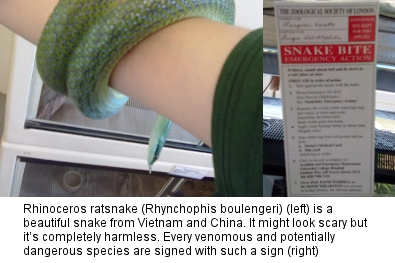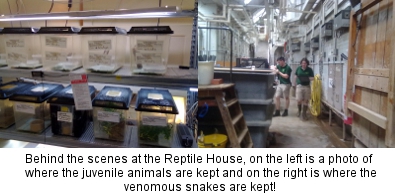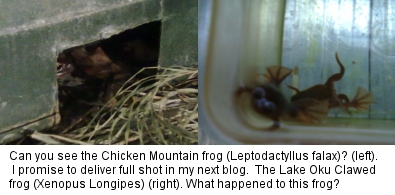Marta Gaworek-Michalczenia is a Vodafone World of Difference Award winner working at ZSL in the Reptile House. Following on from her previous blog she tells us more about what she is doing during her two month placement.
Most of the time during my placement in the ‘Word of Difference Programme’ I am spending in the Reptile House working with Living Collections. The Reptile House opened in 1927 and is currently home to various reptiles including lizards, tortoises, turtles, crocodiles and snakes. Adjacent to the building is the Komodo dragon house and the Giants from the Galapagos Islands – the Galapagos tortoise’s house. The Reptile House obviously contains a considerable collection of amphibians including frogs, toads, salamanders, newts and a caecilian.
Keeping living animals in the Zoo has always had its supporters and opponents. Now I don’t want to go deeper in to this subject (it might be a good topic for my future blog?), but the truth is, the animals are there for a specific reason. Even if the curators have a different vision regarding the collections abundance and species choice, the animals still have the same function: to educate public and work like a true ambassadors to their ‘cousins’ in the wild. People need to see the cultural icons such as the King’s cobra (Ophiophagus hannah), Rhinoceros iguana (Cyclura cornuta) or Poison-dart frogs (Dendrobatidae, Phyllobatidae) to understand the need and importance of conservation. Along with conservation comes valuable research. The more we learn about animals, the better we can preserve them and provide for their needs.
What am I doing on a daily basis?
My placement requires working with living collections every day. Istarted my keeping experience from getting to know the rules of the Reptile House and the place itself. I was very surprised how big the building actually is. From the visitor point of view you are passing several glassed enclosures around the house and probably have no idea what is happening behind the scenes. Let me help you here. The hidden part of the house is much bigger than I expected and contains more species away from the public view. The reasons why the animals stay behind vary. Sometimes it is just a routine check on their health because they were refusing to eat for a few days and sometimes there is a parent in with the new babies in order to minimise the stress.
All enclosures have back doors which allow entrance inside in order to feed and maintain. On my first shift I asked for a stool or a ladder because the doors are often on the chest level, but I got an answer with a smile: ‘We are climbing here’. Then everything became clear. You’d rather be fit and in good condition if you want to do this job. The doors are small, you need to squeeze inside, push your way through the ‘jungle’ to the window with cleaning equipment, watch out for the snake or lizards bite, be resistant to the heat inside. This multiplies 20 times and that is pretty much it! Job done! After my first shift I was worn out!
One of my first observations about working as a keeper was that you are working predominantly on your own. Kind of . I mean you don’t work with other people for the greater part of the day because everybody has their own sections to take care of and they spend most of their time working inside their sections with the same species of animals. It is undoubtedly the kind of routine where many repetitive tasks have to be delivered on a high level every day. These include morning spraying of all animals, checking the temperatures, cleaning the windows from inside (for instruction look above ), feeding, picking up animal waste, cleaning the pools, maintaining the filtration systems and many different things that arises throughout the day. Despite the first impression that it is a physically hard and repetitive work I discovered and developed the incredible pleasure and privilege of working with living animals and the bond with which you are naturally building with the animals you are looking after is an amazing feeling. I don’t feel lonely during my shift anymore because I have 11 Mountain Chicken frogs (Leptodactyllus falax) and 33 Lake Oku Clawed frogs (Xenopus longipes) to speak with. Now they have nice Polish names and I am not embarrassed to say: yes, I am chatting with my frogs.
In my next blog I am going to cover the biggest part of my project which is working with the aforementioned bio-security frogs. At the end of this week I am going to Jersey Zoo to meet with Herp keepers over there and hopefully to learn from them and take their knowledge away back to ZSL.


